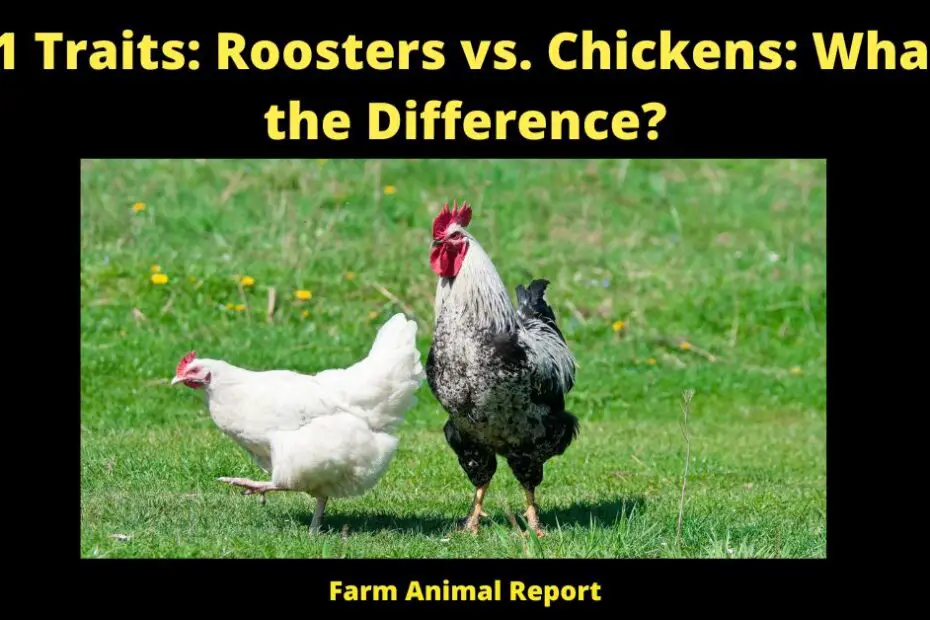Are roosters chickens? This is a question that many people have asked, and the answer is not always clear. In this blog post, we will discuss the difference between roosters and chickens, as well as provide some interesting facts about each.
Roosters vs. Chickens: Are Roosters Chickens?
The Main Difference is – When it comes to chickens, there are two types: hens and roosters. Hens are the female birds that lay eggs, while roosters are the male birds that protect the flock. Both hens and roosters are chickens, but roosters are usually larger and have more brightly colored feathers. Roosters vs. Chickens
Check Out Amazon for Educational Resources for Breeding Chickens
In addition, roosters also have a protrusion on the top of their head called a comb, which is used to cool their brain. Roosters also have a long tail with pointed feathers, while hens have a shorter tail with rounded feathers. What Age Do Roosters Begin to Mate?
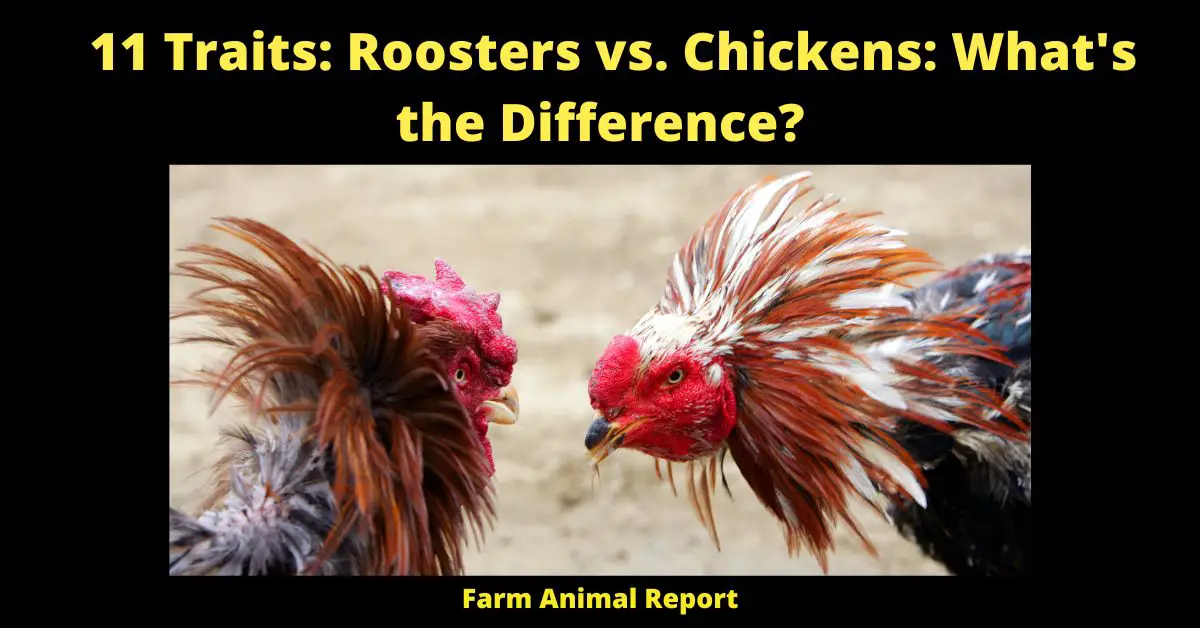
When it comes to behavior, roosters are usually more aggressive than hens and will often fight each other for dominance. However, both hens and roosters can make excellent pets.
Chickens are social creatures that enjoy human interaction, and they can even be trained to do simple tricks. So whether you’re looking for an egg-laying hen or a protective rooster, you’ll be sure to find a chicken that’s right for you. How Many Chickens Per Rooster?
What are Chickens?
Chickens are one of the most common and widespread domestic animals, with a population of more than 19 billion as of 2011. They are kept by humans around the world for their meat and eggs, as well as for their feathers, which are used in a variety of ways.
Chickens are members of the family Phasianidae, which also includes turkeys, pheasants, and partridges. The red junglefowl is the wild ancestor of the chicken, and it is thought that chickens were first domesticated in Asia about 10,000 years ago.
Chickens are now the world’s most common bird, and they are found on every continent except Antarctica. Chickens are social animals, and they typically live in flocks of 20 or more birds. They communicate with each other through a variety of vocalizations, body language, and behavioral cues.
Chickens are omnivorous creatures, and their diet consists of seeds, insects, greens, and other small animals. Chickens typically lay between 200 and 300 eggs per year. The eggs take 21 days to hatch, and the chicks are cared for by the mother hen until they are old enough to fend for themselves. Chickens typically live for 2 to 3 years in the wild, longer in captivity. 7 Scientific Steps – How Do Roosters Fertilize Eggs (Updated 2022)
What are Roosters?
A rooster is a male chicken. Male chickens are also called cocks. A rooster has prominent male characteristics such as a large comb on his head, wattles (long, fleshy, thin lobes of skin that hang down from the lower side of a rooster’s head), and pointy hackles (long, thin feathers that protrude from the back of a rooster’s neck).
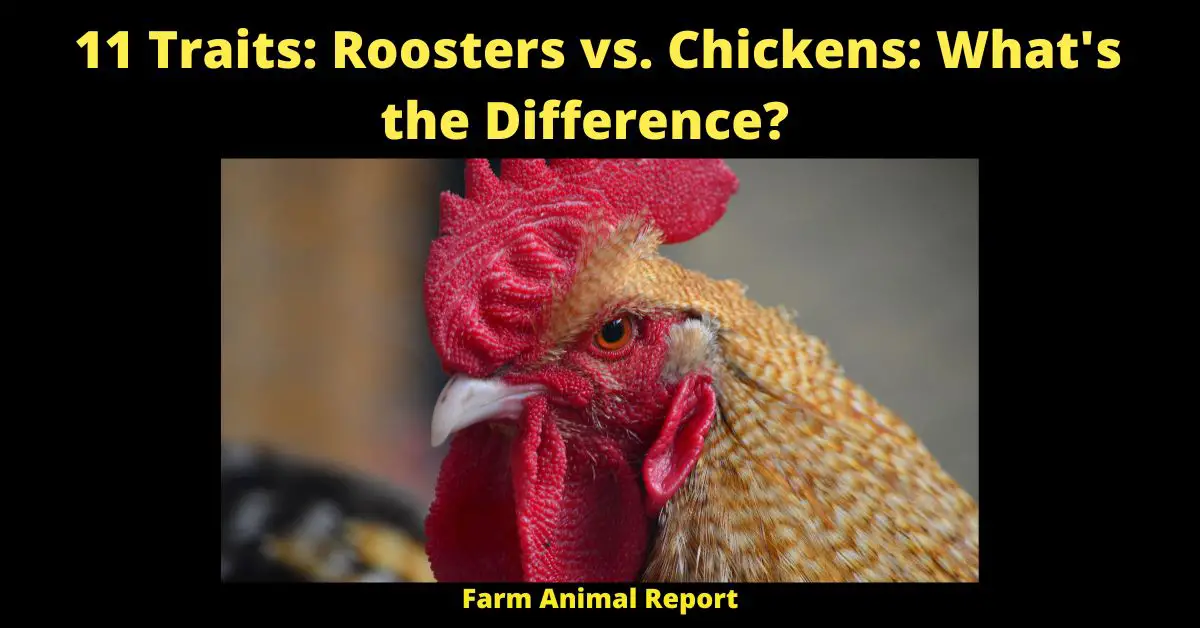
Roosters are usually more brightly colored than hens (female chickens), with characteristic red combs and wattles. In addition to their striking appearance, roosters are also known for their loud crow, which they use to announce the arrival of dawn and signal to other members of their flock.
While some people keep roosters as pets, they are primarily kept for their usefulness in producing fertilized eggs. When a rooster mates with a hen, the hen will lay an egg that contains both the genetic material of the rooster and the hen. These fertilized eggs can then be incubated and hatched, producing chicks that inherit traits from both parents. For this reason, farmers often choose to keep at least one rooster in their flock. Chickens vs Roosters What’s the *DIFFERENCE*
What does a Rooster Look Like?
- Hackle feathers – These are the long, pointy feathers that stick up on a rooster’s neck and back.
- Saddle feathers – These are the large, flat feathers located on a rooster’s lower back.
- Crest – The crest is the fluffy feather tuft on top of a rooster’s head. Not all roosters have a crest, but many do.
- Beard – The beard is a mass of feathers that hangs down from a rooster’s chin. Like the crest, not all roosters have a beard.
- Wattles and Combs – These are the fleshy protrusions on a rooster’s head. The wattles are long and dangly, while the combs are shorter and more erect.
- Leg Spurs – These are sharp, pointy growths that protrude from the back of a rooster’s legs. Not all roosters have leg spurs, but many do.
- Thicker Legs – Roosters have thicker, more muscular legs than chickens. This helps them balance when they perch on top of a fence or other high place.
- Crowing – One of the most distinctive things about a rooster is its crow. A rooster’s crow can be heard from up to a mile away! Hens, Female Chickens, on the other hand, do not crow.
- Tail Feathers – Roosters have long, flowing tail feathers that they hold upright. Chickens, on the other hand, have shorter tail feathers that they tend to hold down close to their bodies.
- Neck Feathers – Roosters have longer, more prominent neck feathers than chickens. This is especially true of the hackle feathers. As you can see, there are several physical differences between roosters and chickens.
- Sickle feathers – These are the long, curved feathers that stick out from a rooster’s tail. Chickens also have sickle feathers, but they are not as pronounced as on a rooster.
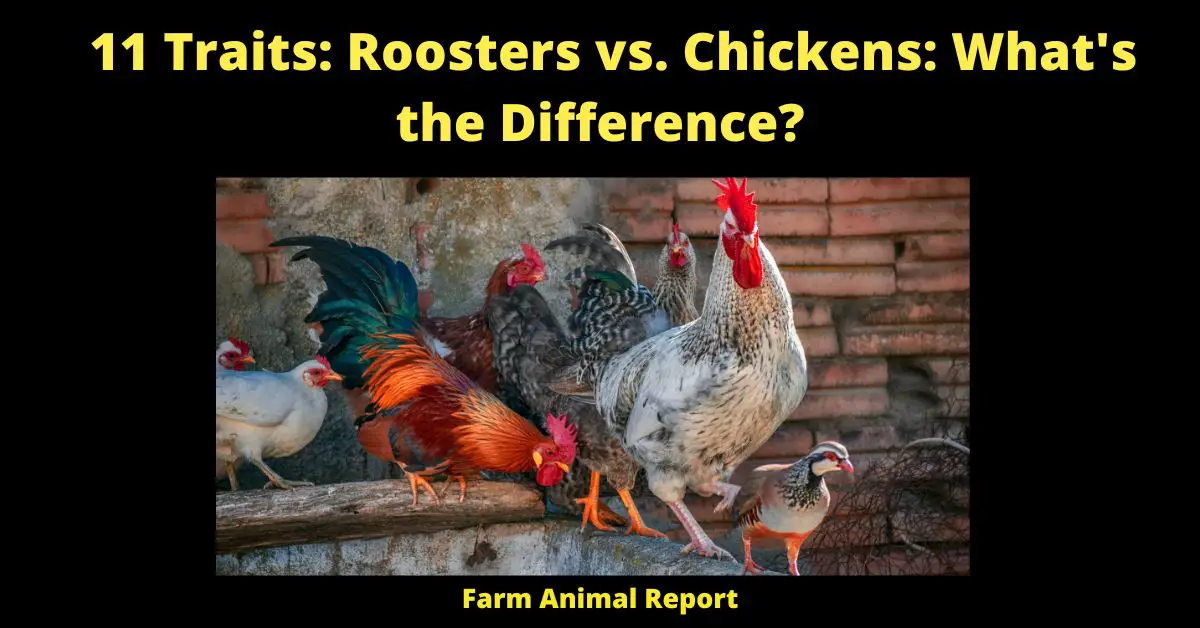
What is a Cockerel?
Cockerels (Roosters) are male chickens, and they play an important role in a farm flock. While hens can lay eggs without a cockerel, having a male chicken around encourages them to lay more often. In addition, cockerels help to protect the flock from predators and will even fight other males to defend their territory.
As a result, most farms choose to keep at least one cockerel for every ten hens. Although they can be useful animals, cockerels can also be quite noisy, especially when they are trying to impress a hen. For this reason, many people prefer to buy hens that have already been mated so that they don’t have to deal with the constant crowing.
What is a Capon?
A capon is a male chicken that has been castrated. This surgery prevents the chicken from maturing and producing testosterone, which in turn makes the meat more flavorful and tender. Simple Surgery: How to Castrate a Rooster (2022)
Capons are typically larger than regular chickens, and they also have a higher fat content. As a result, they are often used for special occasions or roasted whole. While castration may seem like a cruel practice, it actually helps to improve the welfare of the chickens.
Capons live longer and grow slower than regular chickens, which reduces the risk of injuries and provides them with a better quality of life. In addition, because they are not able to mate, there is no need for roosters, which can be aggressive birds. Consequently, capons provide a number of benefits for both farmers and consumers.
How do Female Chickens receive an aggressive Rooster?
Chickens are interesting creatures. They have their own social hierarchy, and they can be very aggressive, especially the roosters. When a new rooster is introduced to a flock, he will usually try to establish himself as the alpha male.
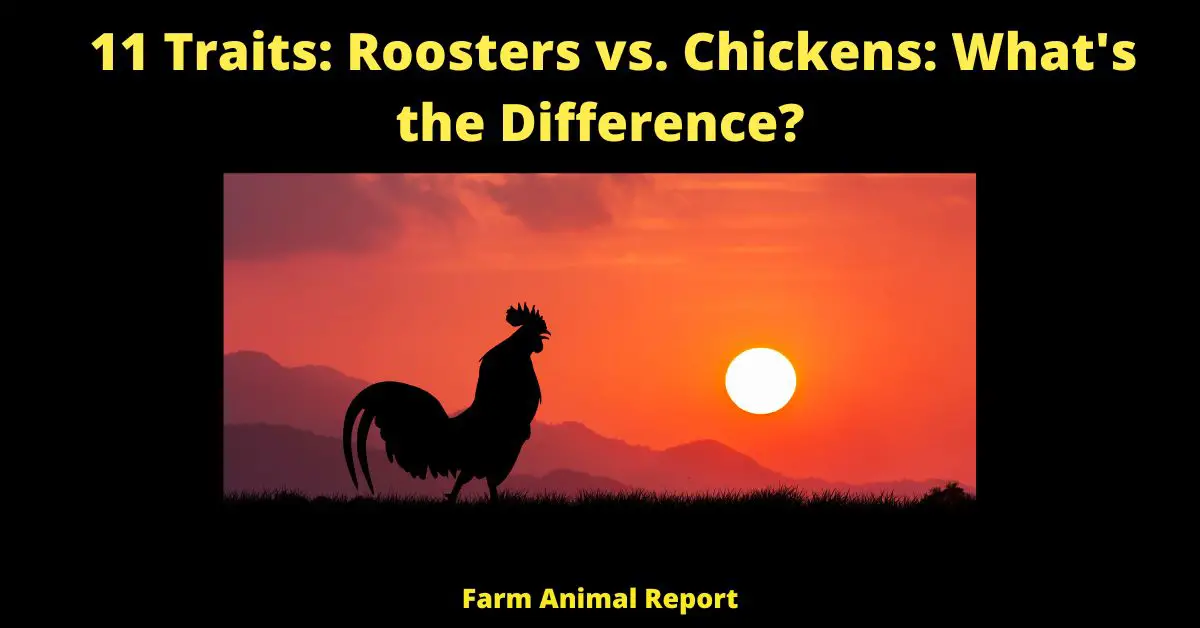
He will attack other chickens, chase them around, and even fight to the death if necessary. However, he will be especially aggressive towards the females. This is because he wants to mate with them and produce offspring. The only way for him to do this is to ensure that he is the only rooster in the flock.
Otherwise, he will not be able to mate with any of the hens. As a result, the females must submit to his demands or face his wrath. Otherwise, they will never be able to have chicks of their own.
How to tell if Baby Chicks are Roosters?
Baby chicks are so darn cute, it’s hard not to want to scoop them all up and take them home. But before you get too attached, it’s important to be able to tell the difference between a rooster and a hen. After all, you probably don’t want your neighbors complaining about the early morning crow of a cock-a-doodle-do. So how can you tell the difference?
One of the easiest ways to tell if a chick is a rooster or a hen is by looking at its legs. Roosters generally have thicker, heavier legs than hens. They also tend to have bigger feet. Another way to tell the difference is by looking at their combs and wattles.
These are the fleshy protrusions on top of a chicken’s head. Roosters usually have larger, redder combs and wattles than hens.
Finally, you can often tell by their behavior. Roosters are typically more active and aggressive than hens, and they like to strut around and show off their feathers. If you’re still not sure, your best bet is to wait until they’re a bit older and then ask your local farmer or vet for help sexing them.
What is vent Sexing in Young Chicks? / Cloacal Sexing
Vent sexing is a process that is used to determine the sex of young chicks. This is typically done when the chicks are between one and three days old. The process involves holding the chick upside down and gently opening the vent, which is located near the tail.
The vent of a male chick will usually be elongated and slightly curved, while the vent of a female chick will be more round in shape. In some cases, additional information can be gleaned from looking at the size and shape of the chick’s cloacal opening. However, this method is not always reliable, so vent sexing remains the most common way to determine the sex of young chicks.
What is the Ratio of Hens to Hens in Hatching Eggs?
The ratio of hens to roosters in hatching eggs is about 50:50, give or take a few percentage points. The sex of the baby chick is determined by the chromosomes in the egg, and there are usually an equal number of each type present.
However, sometimes one type of chromosome may be slightly more common than the other, resulting in a higher percentage of chicks of that sex. In general, though, the ratio of hens to roosters in hatching eggs is close to 50:50. Farmers typically don’t worry too much about the exact proportions, as they usually end up with a mix of both sexes in their flock anyway
Rooster vs Chicken Meat -what is the difference?
When it comes to chicken meat, there is a big difference between rooster and chicken. First of all, chicken is a lot more tender than a rooster. This is because roosters tend to get a lot more exercise than chickens, making their muscles tougher. In addition, rooster meat has a stronger flavor than chicken meat.
This is because roosters eat a lot more insects than chickens, giving their flesh a fuller flavor. Finally, rooster meat is higher in protein than chicken meat.
This is because roosters have more muscle mass than chickens. As a result, they require more protein to maintain their muscularity.
What are the Benefits of Keeping a Rooster in Your Backyard Flock?
When most people think of chickens, they picture a hen clucking around the yard. However, many chicken owners also choose to keep a rooster in their flock.
While some may see roosters as nothing more than noisy pests, there are actually several benefits to keeping one in your backyard flock. For starters, roosters help to protect hens from predators. With their sharp claws and beaks, roosters can fend off coyotes, hawks, and other animals that might try to harm your chickens. In addition, roosters also help to keep hens safe from humans who might try to steal them.
Furthermore, roosters help to boost egg production. By continually mating with hens, roosters stimulate their mate’s reproductive system, leading to increased egg production. Finally, roosters also add value to your flock. While hens can be sold for their meat or eggs, roosters are usually only sold for their meat.
What are the Disadvantages of Keeping a Rooster with your Backyards Flock?
While many people choose to keep a rooster as part of their backyard flock, there are also some disadvantages to consider. First, roosters can be quite loud, especially early in the morning.
This can be a nuisance for neighbors and may even lead to complaints. In addition, roosters can be aggressive, and they may start to view humans as potential threats. As a result, it is important to handle them with care and to keep them away from small children or anyone who may not be able to defend themselves.
Finally, like all male birds, roosters do not lay eggs. So if you are keeping chickens for their eggs, a rooster will not be of much use. Ultimately, whether or not to include a rooster in your backyard flock is a personal decision. There are both advantages and disadvantages to consider before making your choice.
Final Thoughts – Roosters vs. Chickens
Chickens are the generic term for Domestic Chickens which have descended from the Red Jungle Fowl from Southeast Asia. Roosters or Cockerels are the Males of the species. hens being the Female. Roosters are larger, stronger, and more colorful usually than Hens.
God Bless Greg


